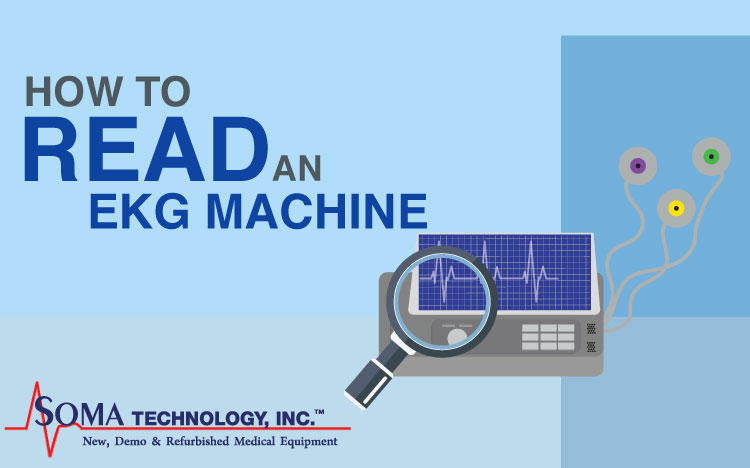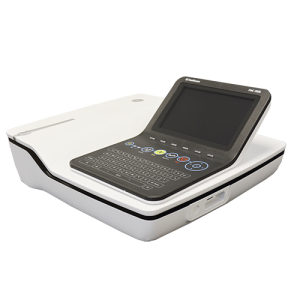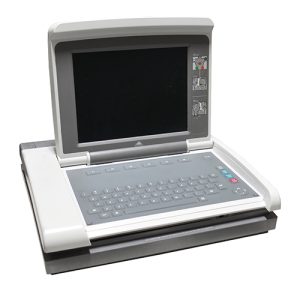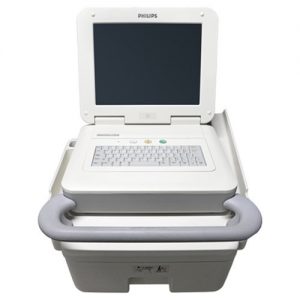How to Read an EKG – Interpreting Waveforms
June 13, 2019
How to Read an EKG
Everyone knows that EKGs are associated with the quality of life of someone inpatient and that the parameters can determine someone’s vital signs. EKGs were designed to monitor cardiac activity. The leads placed on a patient can determine heart activity and transmit it back to other monitors located at the bedside, and an array of monitors at a nursing or physician station. Click to continue to learn more about how to read an EKG.
What are the Different Signs on the EKG?
There are many different signs on an EKG including the heartbeat, pulse, blood pressure monitoring, SPO2, and sometimes temperature. These signs will be identified with numerical figures that each have their parameters of what is considered normal, and what can be indicative of a much larger disease or condition.
How Can We Interpret a Waveform?
Reading an ECG or EKG can be a tough job. Before you can even interpret the waveform, you need to check the patient’s vitals and assess them to see if there is anything immediately wrong that cannot be checked by this unit. Along with the parameters on the screen, these symptoms will help healthcare providers gather a larger picture of what is going on with the patient’s overall health.
The basics of an EKG/ECG wave are the P wave, the PR interval, the QT interval which contains the QRS complex, the ST segment, and the T wave. Attach the 12 leads to the correct spots on the patient, and figure out if the wave is regular or irregular. The rhythm can be normal or abnormal depending on the other factors that were identified during patient assessment. To figure out the rhythm, you need to know if the heart rate is fast or slow. This can also be affected by the medications your patient is taking. There are a few rhythms that will likely result in a decline in health for your patient. These rhythms include the Mobitz Type II, Third Degree Heart Block, Ventricular Tachycardia, and Idioventricular rhythms. If at any point you are still having trouble, then please consult with your healthcare resources.
What if There is No Waveform?
Simply put, no waveform is a clear indicator that the patient’s heart has stopped working. This may mean that they need to be coded, or that they have died. Depending on the patient’s wishes the medical staff may try to resuscitate the patient.
What are Some Particularly Great EKG Machines?
Soma Technology stocks a variety of the most trusted medical equipment manufacturers and some of their most popular EKG machines. Some of the most popular ones are the MAC 2000, GE MAC 5000, GE MAC 5500HD, and Philips PageWriter TC70.
GE MAC 2000
The GE MAC 2000 is a reliable EKG machine. This unit is the first to use the power of the Marquette 12SL analysis program. This EKG features 10-second ECGs with one-touch operation, an easy-to-read 7″ color display, 12 leads, multiple connectivity, and export options. Other features include a 12SL analysis program for clinical decision support and testing configurations for diagnostic needs.
GE MAC 5500 HD
The GE MAC 5500 HD is one of our best-selling EKG units. This unit can precisely capture, analyze, and communicate ECG data. These features include better tools for triage and acute coronary syndrome and have configurable critical values to help speed treatment time. Other features include accurate pacemaker detection for advanced interpretations of paced rhythms. Barcode workflow is enhanced while ECG workflow helps to save time and avoid costly misdiagnoses. This machine weighs about 15 pounds and is laptop-style which allows it to be brought into any patient room. The screen is about 10.4 inches and has diagonal graphics backlit on a color AM LCD. The keyboard is alphanumeric and easy to use.
Philips PageWriter TC70
The Philips PageWriter TC70 is an ECG that specializes in streamlining workflow. This is one of our largest units with a screen of about 15 inches. The touchscreen and alphanumeric keyboard allow for an easy user interface and can simplify treating patients through streamlined care. This machine operates on an 18-lead DXL algorithm. This machine also weighs the most at 28 pounds. The laptop-style makes it easily transportable between patient rooms. The screen has about 64,000 colors that it can display. This unit uses a lithium-ion battery.
Requesting Any of Our ECG/EKG Monitors
We have a dedicated team of sales directors that can help with product knowledge. Our sales team is willing to work on any request for EKG/ECG systems; and for any of our other products. Each sales representative is experienced in outfitting surgical centers, hospitals, and even ambulances. Click here to find the sales representative that serves your area. Each sales rep can be reached at 1-800-GET-SOMA, or on their direct line. They can also be emailed at [email protected]. Call today or email for a quote!
Final Thoughts
Did you know how to read an EKG machine? Did you learn that the different waveforms can be indicators of different conditions? Are you someone who reads EKGs as part of your job? Did we miss a crucial piece of information? Would you say that there is a brand of medical equipment that you enjoy using more than others, or one that you trust the most? Comment below!
Explore Other Blog Items By Category
Recent Posts


EKG vs ECG | What’s the Difference Between ECG and EKG?





1 comment